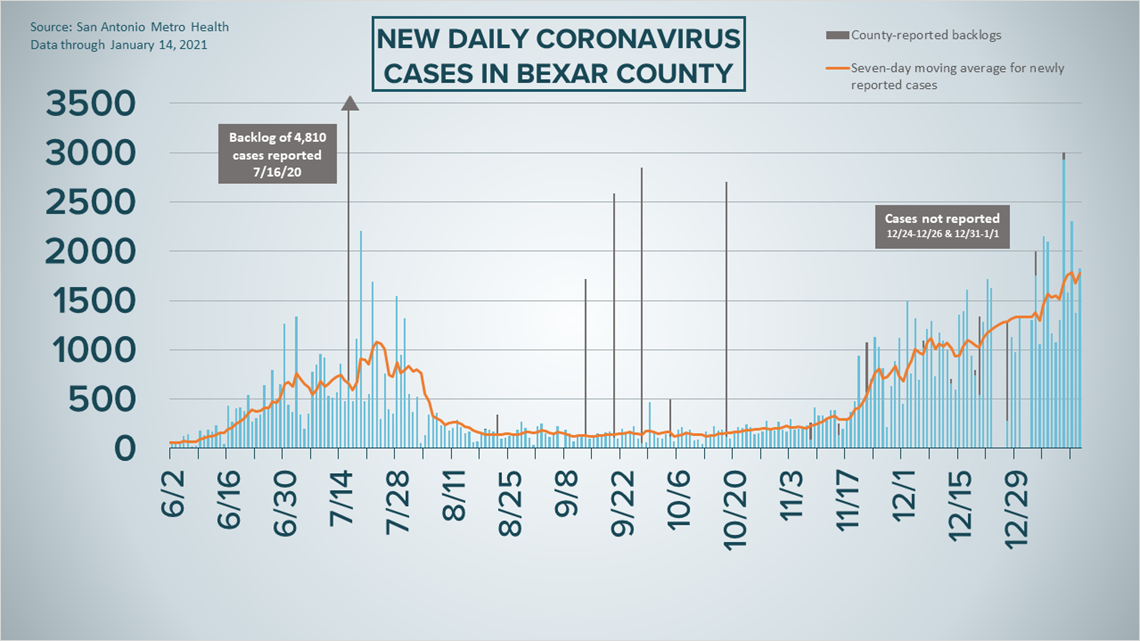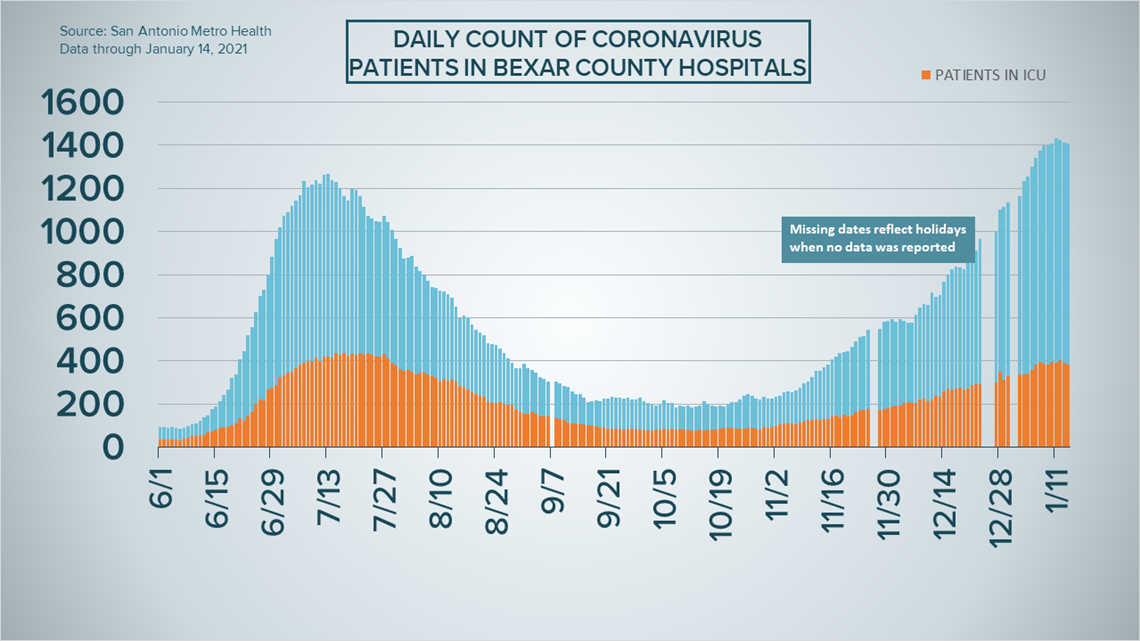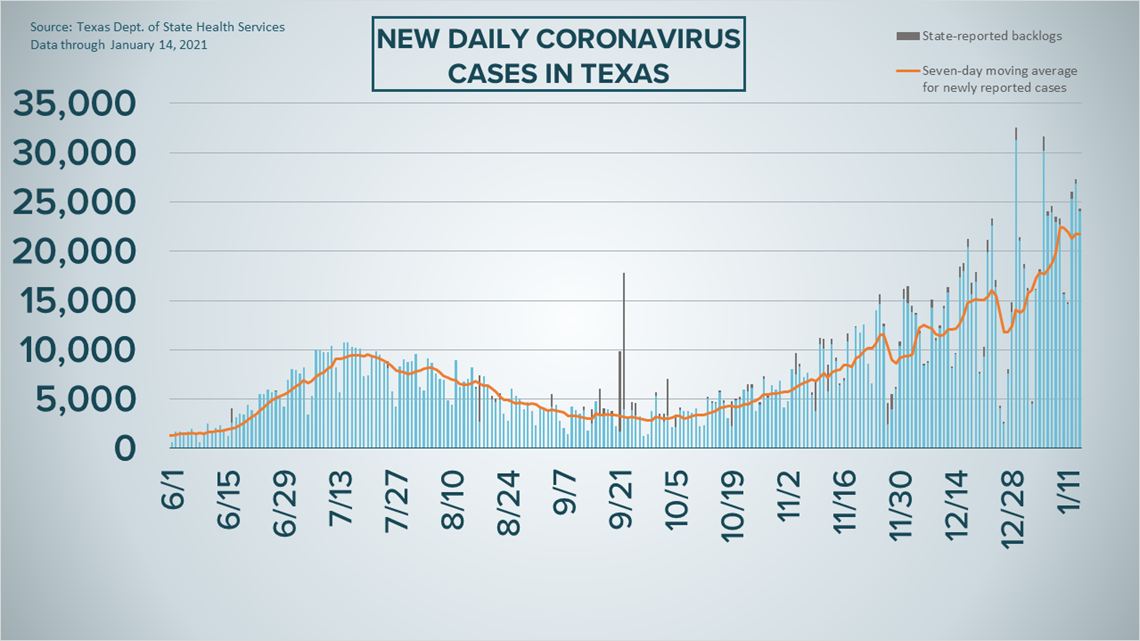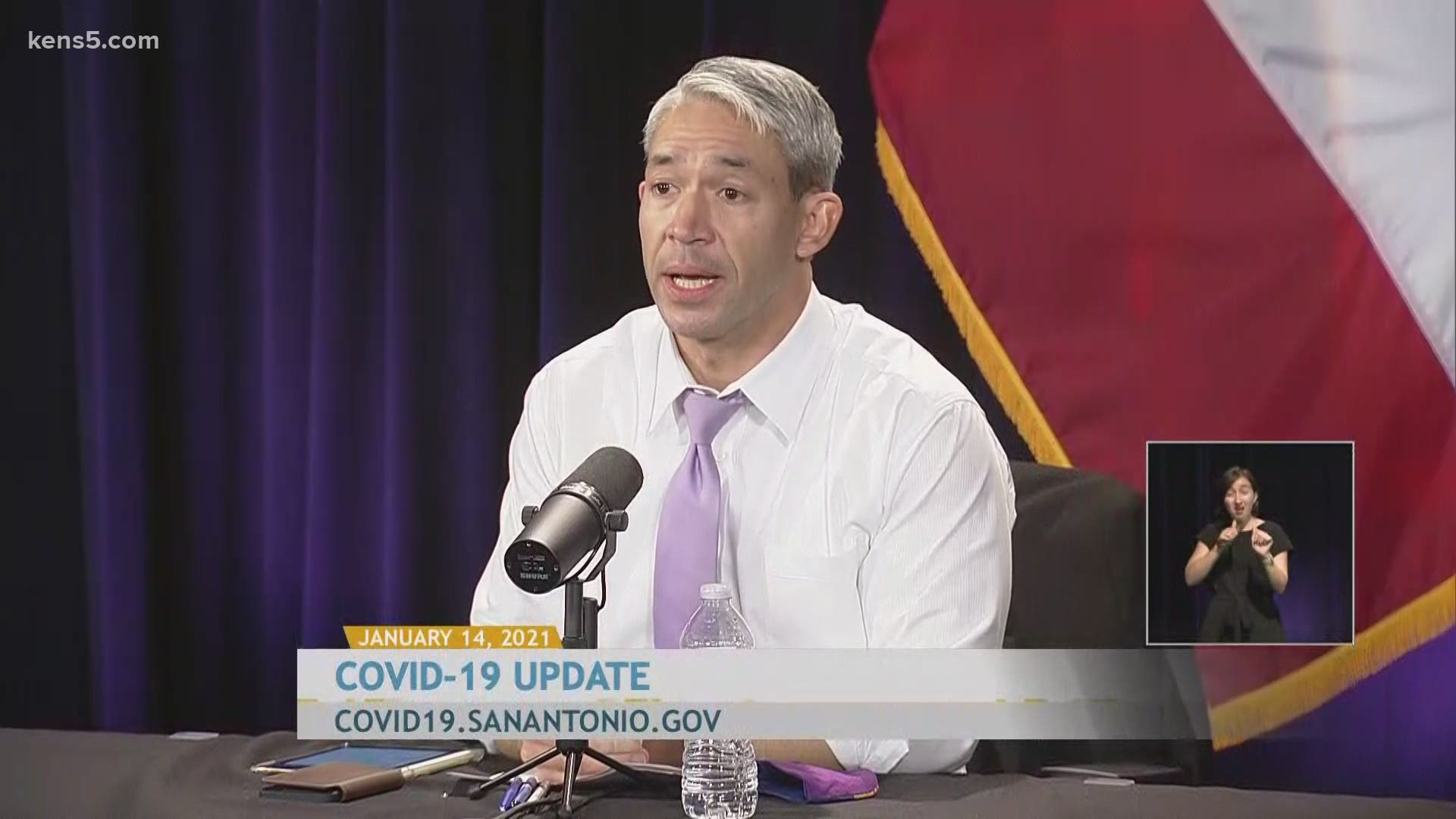SAN ANTONIO — We're tracking the latest numbers from the coronavirus pandemic in San Antonio and across Texas. Here are the latest numbers reported by Bexar and surrounding counties:
- Bexar County: On Thursday, 1,829 new cases were reported, bringing the total number of cases to 140,614. 19 new deaths were also reported, raising the local death toll to 1,704.
- Hays County: Officials in Hays County Thursday reported 186 new cases in the county and one additional COVID-related fatality. As of Thursday, there are a total of 12,809 lab-confirmed local cases, while the death toll rose to 148. Officials estimate 10,329 residents have recovered, while 2,322 are still ill with the virus.
- Comal County: On Friday, Comal County officials reported 97 new cases and five additional COVID-related fatalities. There are a total of 7,245 cases, including 4,131 confirmed and 3,101 probable cases, while 201 county residents have died due to COVID-19 complications. The county estimates 6,213 residents have recovered, while 831 are still ill with the virus.
More county case information is available through the Texas Department of Health Services COVID-19 dashboard.
Stay updated with our latest information on coronavirus vaccines and local vaccine distribution with our ongoing Vaccine Tracker.
How Bexar County is trending
We've tracked how many coronavirus cases have been confirmed in Bexar County from the time officials began reporting cases in March 2020. The graphic below shows the number of cases since June and charts those daily case numbers along a 7-day moving average to provide a more accurate picture of the overall coronavirus case curve in our area and the direction we're trending amid the pandemic.
On Thursday evening, San Antonio Mayor Ron Nirenberg reported an additional 1,829 novel coronavirus cases, bringing the total number of local diagnoses to 140,614. The seven-day moving average rose to 1,782 cases a day.
The local death toll rose to 1,704 Thursday when Nirenberg reported 19 additional coronavirus-related deaths in the county.


Meanwhile, 158 new patients were admitted to local hospitals in the last 24 hours for coronavirus-related treatment, though the number of hospitalizations dipped slightly to 1,407 on Thursday. That amounts to four fewer overall patients compared to Wednesday.
Both the number of patients on ventilators (231) and the number of those in intensive care (382) decreased in the last 24 hours.


Officials said that 34.5% of all hospitalized patients have COVID-19. One patient from El Paso is being treated in Bexar County.
Coronavirus in Texas
The total number of novel coronavirus cases in the state since the pandemic began grew by 24,325 on Thursday, according to the Texas Department of State Health Services. That total includes 20,047 new confirmed cases, 3,968 new probable cases, and 310 cases attributed to backlogs not previously reported in the state's total (more details can be found at the top of this page).
Thursday's report brings the total number of Texans diagnosed with COVID-19 to 2.045 million Thursday, one day after the state officially surpassed the 2 million case mark.
According to DSHS data, it took more than 250 days for Texas to accumulate 1 million cases, and just 60 for that number to reach 2 million.


State health authorities also reported 426 additional virus-related deaths on Thursday. At least 31,050 Texans have now died from COVID-19 complications.
The number of Texans receiving treatment at hospitals for coronavirus symptoms fell by 54 over the last 24 hours. On Thursday, the concurrent total stood at 14,052, marking just the third day of more than 14,000 COVID-19 hospitalizations across the state since the pandemic began.
The state estimates that about 1.63 million Texans have recovered, while 366,475 Texans remain ill with COVID-19.
The latest update from the Texas Education Agency showed that there have been at least 102,558 cumulative cases among staff and students across the state through January 3. That number comprises 64,574 positive student cases and 38,011 staff cases. More information can be found here.
The TEA releases new data on school cases on Fridays.
Latest Coronavirus Headlines
- Joe Biden's pandemic plan: $1,400 checks, extended unemployment, faster vaccine rollout
- Is it safe for pregnant women to get the coronavirus vaccine?
- Texas becomes first state to administer 1 million COVID-19 vaccines
- Why you need two doses of the Pfizer and Moderna vaccines | KENS 5 Vaccine Team
- COVID-19 Vaccine Tracker: Fast facts and how to participate in Phase 1B distribution in San Antonio
- UT models now suggest Austin-area ICU capacity to reach limit on Jan. 21
- Woman who knew she was COVID-19-positive attended concert at Cowboys Dancehall
- Trump's Mar-a-Lago warned over coronavirus mask violations on NYE
- Vatican: Pope Francis receives coronavirus vaccine
Coronavirus symptoms
The symptoms of coronavirus can be similar to the flu or a bad cold. Symptoms include fever or chills, cough, shortness of breath or difficulty breathing, fatigue, muscle or body aches, headache, new loss of taste or smell sore throat, congestion or runny nose, nausea or vomiting, and diarrhea, according to the Centers for Disease Control.
Most healthy people will have mild symptoms. A study of more than 72,000 patients by the Centers for Disease Control in China showed 80 percent of the cases there were mild.
But infections can cause pneumonia, severe acute respiratory syndrome, kidney failure, and even death, according to the World Health Organization. Older people with underlying health conditions are most at risk.
But infections can cause pneumonia, severe acute respiratory syndrome, kidney failure, and even death, according to the World Health Organization. Older people with underlying health conditions are most at risk.
Experts determined there was consistent evidence these conditions increase a person's risk, regardless of age:
- Chronic kidney disease
- COPD (chronic obstructive pulmonary disease)
- Obesity (BMI of 30 or higher)
- Immunocompromised state (weakened immune system) from solid organ transplant
- Serious heart conditions, such as heart failure, coronary artery disease, or cardiomyopathies
- Sickle cell disease
- Type 2 diabetes
The CDC believes symptoms may appear anywhere from two to 14 days after being exposed.
Human coronaviruses are usually spread...
- Between people who are in close contact with one another (within about 6 feet).
- Through respiratory droplets produced when an infected person coughs, sneezes or talks. These droplets can land in the mouths or noses of people who are nearby or possibly be inhaled into the lungs.
- Some recent studies have suggested that COVID-19 may be spread by people who are not showing symptoms.
Help stop the spread of coronavirus
- Stay home when you are sick.
- Eat and sleep separately from your family members
- Use different utensils and dishes
- Cover your cough or sneeze with your arm, not your hand.
- If you use a tissue, throw it in the trash.
Find a Testing Location
City officials recommend getting a COVID-19 test if you experience fever or chills, cough, shortness of breath or difficulty breathing, fatigue, muscle or body aches, headache, new loss of taste or smell, sore throat, congestion or runny nose, nausea or vomiting, or diarrhea.
San Antonio operates several no-cost testing locations, including two walk-up locations open Monday-Sunday from 10 a.m. until 2 p.m.:
Cuellar Community Center
5626 San Fernando St.
San Antonio, TX 78237
Ramirez Community Center
1011 Gillette Blvd.
San Antonio, TX 78224
Additionally, Freeman Coliseum offers drive-through no-cost testing from Monday through Sunday between 9 a.m. and 4 p.m. An appointment is required and can be made either online or by calling (833) 213-0643.
Here's a Testing Sites Locator to help you find the testing location closest to you in San Antonio.

